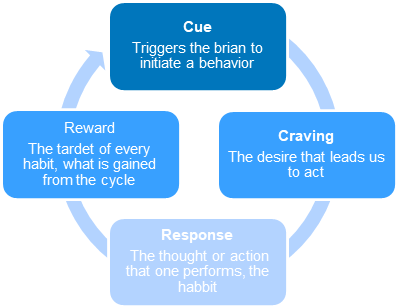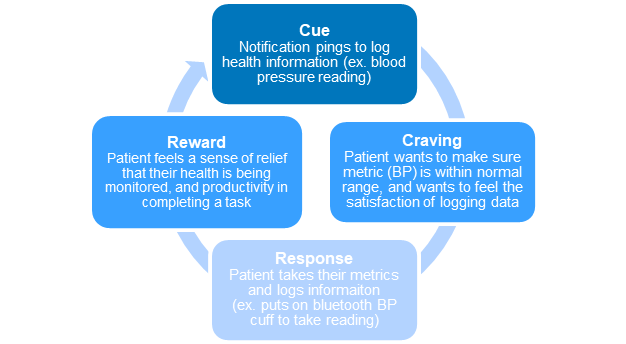As a patient transitions from hospital to home, leaving the safety net of doctors and nurses may seem daunting. For patients, half of the struggle of coming home is forming new, healthy habits; habits that help them manage their lives post hospital discharge. Whether this means remembering to take their medicine or eating healthy or regularly checking their weight, developing new habits and forming a new routine is essential to reducing a patient's risk of readmission. Many patients are unable to form new habits, as they do not have the resources to do so. Telehealth and remote patient monitoring tools are a great solution for empowering patients to change their behavior and ultimately improve outcomes and reduce readmissions.
What is a Routine?
A routine is a series of actions composed of multiple habits that a person performs on a regular basis. An article in Psychology Today explains how habits form when new behaviors become automatic and subconscious. While bad habits are easy to develop and tough to break, good habits are hard to develop and difficult to sustain. When trying to develop a good routine, one must first concentrate on forming good habits. There is an intrinsic link between telehealth, changing patient behavior, and improving health outcomes and literacy. The psychology behind behavior change and why/how new habits form is crucial to understand when building and implementing a telehealth program.
How Habits Form
To understand the benefits behind a routine, it’s important to comprehend how habits form. In the book Atomic Habits, author James Clear explains the four different steps to develop a habit:
-
-
Cue: something that triggers the brain to initiate a behavior. The trigger is initiated due to the brains recognition of a potential reward. This reward can be as essential as food, shelter, water, or health, or a secondary reward such as money, fame, approval, excitement, love, or satisfaction. Our minds are constantly scanning both our internal and external environments to pinpoint where rewards can be found. Once a reward has been detected, the next stage, craving, is initiated.
-
Craving: the motivational force that drives every habit. The craving is the desire that leads us to take action. The craving is not for the habit itself, but rather the change it delivers. For example, alcoholics do not crave drinking alcohol, but rather the release of endorphins the drinking initiates which leads to feelings of pleasure. If a craving is powerful enough, the next step is our bodies response to that craving.
-
Response: a thought or action that one performs, the habit.
-
Reward: the goal of every response/behavior. The reward satisfies the initial craving. Rewards have the unique ability to train the mind to recognize which actions are worth remembering and repeating in the future, ie, what should become a habit. This is determined by which actions appease our desires and transmit pleasure. Our brains can monitor which actions are useful and which are useless. The brain determines whether a habit is useful depending on whether it satisfies the initial craving. This means bad habits can be deemed useful, even though they may not be healthy. The habit of eating ice cream for dessert is not healthy, but it is conceived useful to the brain because it satisfies the initial craving of wanting something sweet.
-
For behaviors that successfully make it through these four steps and are deemed useful, rewards close the feedback loop. Once this loop is closed, the habit cycle is formed.

Figure 1: Habit Forming Cycle (Site 1)
Once a habit is formed, the tasks become something we do automatically without thinking. Setting a routine requires thought and deliberate creation of habits, but once you become accustomed to the routine, it becomes an unconscious and seemingly automatic series of actions.
How Telehealth & Remote Patient Monitoring (RPM) Change Patient Behavior
Remote Patient Monitoring (RPM) solutions are meant to empower patients to take their health monitoring into their own hands. Patients enrolled in a telehealth program have multiple different tasks which they must complete every day in order to keep up with their care and experience the benefits of the telehealth system. Whether a patient is taking his or her vital signs, watching an educational video, or simply logging their activity, the patient is held accountable for their healthcare regimen.
Patients are held accountable because although RPM provides the necessary telehealth tools, it is up to the patient to take advantage of and use them. They must follow their personalized recovery plan, log their information, and in return, they get real time monitoring results on how they are doing. Patients see their progress or missteps and are motivated to keep going or try harder. By repeating rehabilitation tasks every day, the patient develops multiple good habits that all come together to form a healthier routine. Using James Clear’s habit-forming model, each habit RPM helps to initiate can be explained.

Figure 2: Telehealth application of Habit Forming Cycle
This example is one of the many habits that telehealth aims to create in its patients. A common theme behind all RPM is the motivation it creates in patients to become more self-sufficient and involved in their health care regimen. Many telehealth companies are enforcing this by incorporating educational materials and personalized alerts to spark action. Both play a role as the cue which initiates the craving to continue using telehealth to take care of their health. In response, they keep using the telehealth solution, and the reward is avoiding ED visits, readmission, or poor health outcomes.
Importance of Behavior Change in Healthcare
The ability of RPM to influence patient behavior is significant. A study conducted in the Journal of Medical Internet Research explained how the global level of chronic disease has significantly increased, and telehealth initiating behavior change will help to alleviate this epidemic. Chronic disease is currently the leading cause of death in the United States, and approximately 70% of deaths and 75% of annual health care costs are associated with chronic conditions. Most chronic conditions are caused by health damaging behaviors. Unhealthy habits such as tobacco use, lack of physical activities, inefficient sleep, and poor eating habits, are often what cause and worsen these diseases.
Many chronic diseases can be prevented, delayed, or alleviated through lifestyle changes, changes which RPM initiates. Telehealth and remote patient monitoring have the ability to alter patient behavior, so that patients can set healthy habits that stick. Rather than a recurring cycle of patients getting repeatedly admitted, these solutions enable unhealthy habits to be squashed. Telehealth empowers patients to establish a healthy routine, and thus readmission rates are significantly lowered. These habits initiated by telehealth help the patient not only recover but also manage their own recovery and develop life-long healthy routines.
Resources:
-
CLEAR, JAMES. ATOMIC HABITS: an Easy and Proven Way to Build Good Habits and Break Bad Ones. RANDOM House BUSINESS, 2019.
-
Dinesen, Birthe, et al. “Personalized Telehealth in the Future: A Global Research Agenda.” Journal of Medical Internet Research, vol. 18, no. 3, 2016, doi:10.2196/jmir.5257.
-
“Habit Formation.” Psychology Today, Sussex Publishers, psychologytoday.com/us/basics/habit-formation.
-
HasaHasa, and Hasa. “Difference Between Habit and Routine: Habit vs Routine.” com, 8 Sept. 2016, www.differencebetween.com/difference-between-habit-and-vs-routine/.
-
Jr, William C. Shiel. “Definition of Chronic Disease.” MedicineNet, medicinenet.com/script/main/art.asp?articlekey=33490.
-
Northwestern Medicine. “Health Benefits of Having a Routine.” Northwestern Medicine, 2016, www.nm.org/healthbeat/healthy-tips/health-benefits-of-having-a-routine.